Ring has continued to stay at the forefront of the video doorbell market, as well as continually adding other security devices. The most consistent issue that comes forward when discussing the options with potential buyers can be the cost. Others will argue “why do I need that?” or the issues of charging batteries on a semi-regular basis. One of the most recent additions to the Ring range is the Ring Doorbell Wired which addresses the main concerns.
The Video Doorbell Wired is a smaller and simpler implementation of their doorbell that costs less than the other options they have. It brings a huge amount of functionality from the higher cost devices including:
- 1080p Video with two-way talk
- Customisable motion detection settings
- Alexa integration
Where it differs is the fact that it’s a 240V hardwired doorbell which makes installation a little more complex, but removes the hassle of batteries. This makes the packaging pretty simple with the box containing just a few items; the doorbell, power cable and the screws for mounting and securing the doorbell.
Setup, installation and using the doorbell
Setting up any Wi-Fi device these days is pretty simple, this time around I had a friends son set up the Doorbell Wired and it took a total of 11 minutes. That included setting up the account, hooking up to Wi-Fi, a firmware upgrade and testing the doorbell motion alerts. It is just so simple these days!
Because the app hasn’t changed since the previous reviews if you want to take an in-depth look at the app, check out our Video Doorbell 3 Plus review. What has improved with time is the alerts and streaming quality users will see. A couple of variables that you’ll need to consider are the upstream bandwidth you have on your home Internet and power-saving settings on your mobile device.
From personal experience, I would happily recommend users to have at least 5Mbps upstream as a minimum, otherwise, you’ll have to reduce the quality and will see some compression artifacts on your stream. To make sure you get alerts in a timely manner, it’s worth making sure you add an exception to any power settings, allowing the Ring appt to run without restricting its use of data and power.
The physically smaller size of the Doorbell Wired lends itself to installation in tighter spaces, or even on door frames where the battery-powered options simply won’t fit. It’s secured with two screws to the frame, one top and one bottom of the device. The outer frame secures by a single security screw which (once in place) you shouldn’t ever need to remove.
To make sure you get the best from your doorbell (or security cameras) it’s recommended to try it where you plan to mount it. In this case, there’s a little bit of risk involved because of the way the power is mounted on the rear. The way to overcome this is to cover the exposed wire with some electrical tape while you test the view offered by your planned mounting position.
Once you’ve found the best spot for the doorbell, you’ll need to have a think about how you’re going to run power to the device. There’s plenty of cable on the power block, so find what the best mounting point is, then figure out how to get the power there. In this case, a simple and small hole through the door frame was more than enough to get the power through and resulted in a very clean installation.
What’s missing?
I have a couple of fairly minor issues with the Doorbell Wired which need to be mentioned. With the Doorbell 3 Plus, the pre-roll is an excellent additional feature that’s not provided with this device. The other is — a consistent gripe I’ve had with Ring for years — that there’s no chime provided with it. I completely understand that this is an accessory that Ring make more money from and you don’t need it, but without the chime, you’re not getting the full functionality and experience.
There’s a couple of options here that you can explore. Either by purchasing the chime or if you’ve got an Alexa device, Ring integrates so quickly and easily offering you announcements of people at the door and (with video screens) automation to show who’s at the door and to be able to talk to them from your screen.
Ring Protect: Worth the money?
Subscription options that bring further features to platforms like Ring are now the norm. You’ll get a functional device and don’t need to subscribe, but if you do you’ll see an increase in functions that make devices simply, better.
The tiers for Ring Protect are free, basic ($4 per month or $40 per year) and plus (15 per month or $150 per year) with more and more features added with the two paid tiers. Take a look at the feature list, decide what you want and need, then commit to a plan.
Should you buy one?
I make no effort to hide the fact that I love gadgets like this, so with some questions answered, I’d happily point people to yes. Those questions have been covered throughout this review, but the shortlist is:
- Is the cost of purchase an issue for you with the battery powered models?
- Is charging or changing batteries a concern for you?
- Do you have limited space to install a video doorbell?
While you’re not going to get some of the features of the higher end devices, this is significantly lower cost and certainly isn’t crippled by the features left out. It won’t ever need to be taken down once installed and can be installed in a lot less space than other Ring models.
If you need decide to go down the subscription pathway, it’s easy to understand what you’re getting and is a very affordable addition. If you’re building your smart home with a Ring Doorbell, it’s worth noting that — IFTTT works — the best integration is with Amazon Alexa because it just works!
The notification quality and timeliness from Ring make their devices very useful, in fact, I’d argue, a must-have for security and peace of mind in your home. The fact that Ring has such a wide range of other compatible devices makes it ideal for users wanting to start a home security setup and build on it over time.
The Ring Video Doorbell Wired is available for $119 through the normal retail stores and online channels.
Disclosure Statement
The device is permanently attached to the house and PR have not requested its return.













